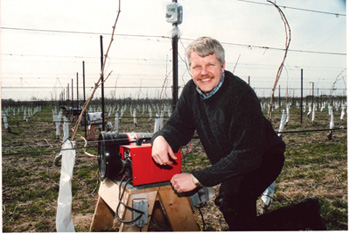
Features
Production
Research
Electric blankets on grape vines an option to fans, inventor says
March 31, 2008 By Jim Meyers
Growing up tinkering with
electronics in the garage on the family grape farm, and going on to
become an electrical engineer with a knack for innovation, provided the
background for Tom Kerber’s latest idea – electric blankets for grape
vines.
 |
| Tom Kerber leaning on one of two step down transformers for each row of grapes. Vine heaters are the silent way to protect grape vines over a harsh Canadian winter, he says. Photo by Jim Meyers |
Growing up tinkering with electronics in the garage on the family grape farm, and going on to become an electrical engineer with a knack for innovation, provided the background for Tom Kerber’s latest idea – electric blankets for grape vines.
It’s a guaranteed way to protect a vine from even the coldest Canadian winter, but he’ll have to play catch-up to convince growers who are not already locked in to other technology. Many have already invested their crop insurance payments from three consecutive cold winters into large wind machines that can cost $40,000 each. The giant fans pull warm air down to mix with colder air on the ground raising the temperature a few critical degrees to save the vine.
Still, Kerber says there’s still a lot of unprotected acreage and he believes he has a shot at commercial success because the vine heaters cost less to operate and can cover areas that wind machines can’t. He figures they cost $1 per acre to operate compared to wind machines fired by propane or diesel fuel that cost $4.50 to $5.50 per hour. As well, while wind machines that can each cover 10 acres (four hectares) are best suited for large, flat vineyards, his electric blankets are more suitable for smaller vineyards and those planted on slopes.
A silent alternative
“There’s the Cadillac version (each vine temperature controlled) and the Chevette version (each row),” Kerber says about his silent alternative to wind machines, which neighbours have complained sound like helicopters taking off.
The vine heaters operate like engine block heaters but on low voltage, and are wrapped in an insulated foil blanket. They are environmentally friendly because they draw power late at night and early in the morning during off-peak hours. Since they are thermostat controlled to keep vines about 100C degrees above the
ambient temperature, they draw only as much power as needed, Kerber adds.
The unknown and yet-to-be determined cost is wiring a large vineyard and the labour costs of putting the blankets on vines each fall and taking them off in the spring. But Kerber believes the payback is there based on lower operating costs and superior vine hardiness resulting in better yield.
The idea is being fine-tuned for commercial application by Kerber Applied Research Inc. based in Stoney Creek and is protected by patent pending.
Tom says there wasn’t a real eureka moment attached to his idea, which came to him late last summer. It was more a case of necessity being the mother of invention. He put it to the test this past winter on the Twin Poplar family farm, run by his brother Richard near the airport in Niagara-on-the-Lake. The farm wasn’t hard to spot this past winter. It was the one without wind machines. Instead, there’s a hydro meter on the headland and, until they were removed in mid-April, white reflective foil blankets on some 3,200 tender vinifera Merlot vines.
Electricity was brought into the vineyard underground through thick, insulated cable and the voltage was stepped down. There are two small step-down transformers for each row of grapes with the power running from the middle of the vineyard to each end in order to maximize the strength of the current carried through insulated electrical cable strung along the lowest fruiting wire.
The blankets covered the trunk of the vine from the trellis wire down to the crucial graft point where the vinifera vine is attached to hardier rootstock. A felt plug at either end keeps the heat in.
Mild winter foils test
Kerber feels he could have easily proven the superiority of his blankets if it hadn’t been the mildest winter ever recorded in Niagara and in most of Canada. The three previous winters were cold with temperatures dipping to –230C and colder in some places. That’s taken a toll on vineyards that have been wiped out or heavily damaged in Niagara and elsewhere in Ontario, resulting in 2005’s harvest being the smallest crop ever recorded. That’s in spite of record plantings in previous years coming into production to meet a growing demand by wineries.
Besides the test plot on the family farm, there is also a study underway in the vineyard at Niagara College. Two vines with the blankets were studied at a vineyard weather station in conjunction with a three-year study of wind machines.
Print this page